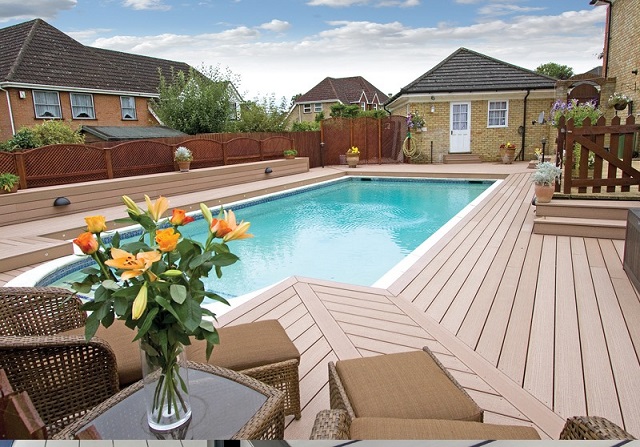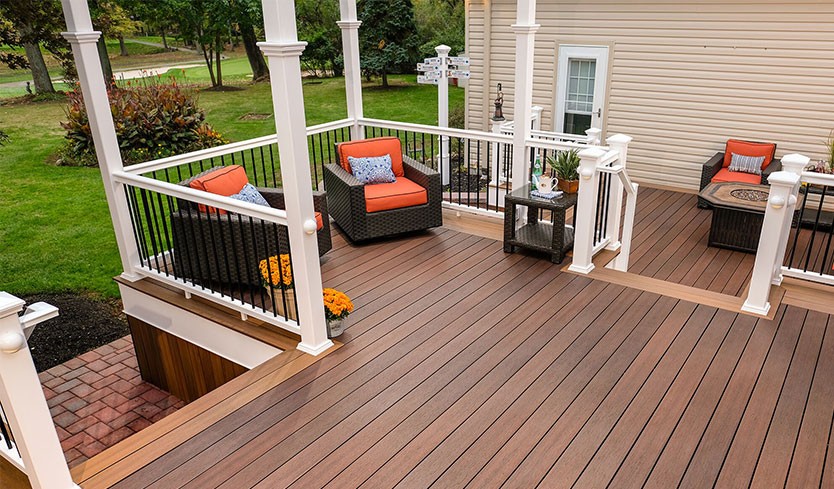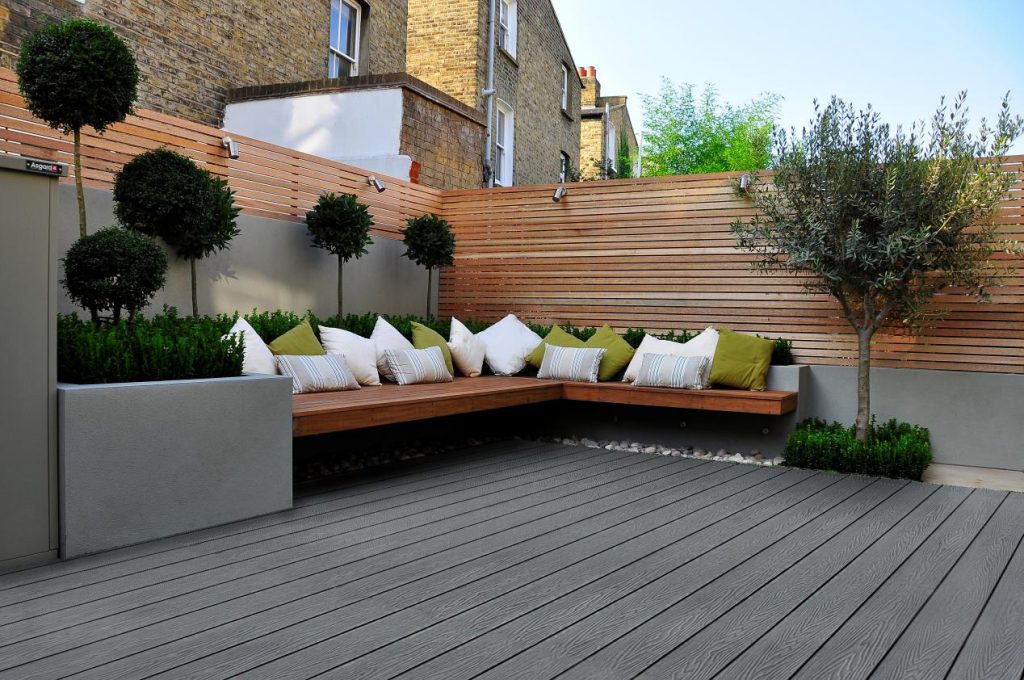When it comes to designing or renovating a swimming pool area, one of the most critical decisions is selecting the right decking material. Composite decking for swimming pools has become an increasingly popular choice for homeowners, designers, and contractors due to its durability, aesthetic appeal, and low maintenance needs. But how do you choose the best composite decking for your pool? What factors should you consider to ensure your outdoor space is both beautiful and long-lasting?
Table of Contents
This comprehensive guide will walk you through everything you need to know about choosing composite decking for swimming pools — from materials and colors to sizes and suppliers — helping you make an informed decision for your aquatic retreat.
What Do You Know About Composite Decking?
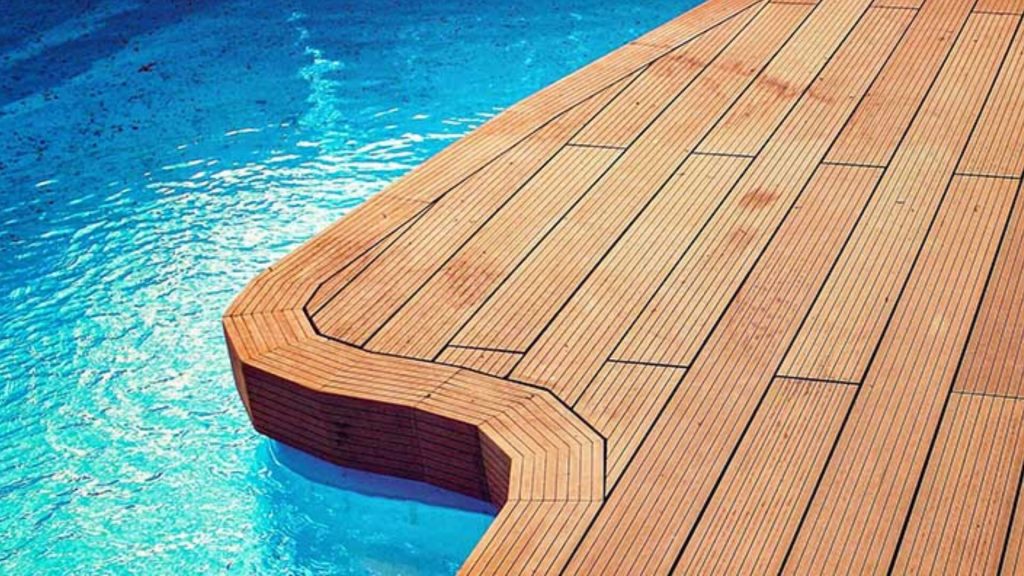
Before diving into the specifics of selecting composite decking for swimming pools, it’s essential to understand what composite decking actually is. Composite decking is a man-made building product that combines wood fibers or wood flour with plastic materials. This blend creates decking boards that mimic the look and feel of natural wood but with improved performance characteristics.
Unlike traditional wood decking, composite boards resist rot, insect damage, and warping. They also require less maintenance, making them ideal for outdoor environments exposed to moisture — such as pool areas.
Why Choose Composite Decking for Swimming Pools?
Swimming pool environments pose unique challenges for decking materials. Constant exposure to water, chemicals from pool treatments, sunlight, and foot traffic demands a decking solution that offers:
Durability: Resistance to moisture, mold, and mildew.
Slip Resistance: Safety to prevent slips and falls when wet.
Aesthetic Appeal: An inviting look that complements the pool and landscape.
Low Maintenance: Minimal upkeep compared to wood.
Weather Resistance: Ability to withstand UV rays and temperature fluctuations.
Composite decking checks all these boxes and is increasingly favored over traditional wood and concrete for pool decks.
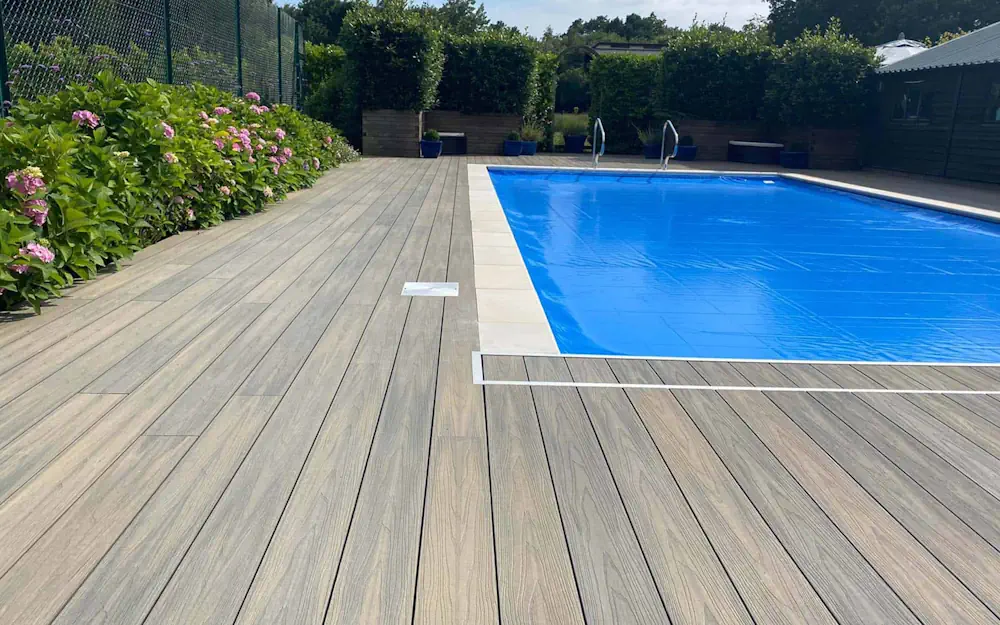
How to Choose Composite Decking for Swimming Pools
Choosing the right composite decking involves evaluating several factors tailored to your specific needs and environment. Below are the main considerations:
1. Material Composition and Quality
Composite decking boards are typically made from a mixture of wood fibers and recycled plastics. However, the ratio, type of materials used, and manufacturing process can vary widely, affecting the board’s quality and performance.
Wood-Plastic Composite (WPC): This common type combines wood fibers with polyethylene or polypropylene plastic. WPC boards tend to have a natural wood-like texture and appearance.
PVC Composite: Made primarily from polyvinyl chloride, these boards are 100% plastic, making them more resistant to moisture but sometimes less natural in look and feel.
Capped Composite Boards: These have a protective outer shell or cap made of a polymer material, which enhances durability, stain resistance, and UV protection.
For swimming pools, selecting a composite decking board with a high-quality cap or enhanced surface layer is advisable. This cap protects against fading, staining from pool chemicals, and moisture penetration, extending the lifespan of your decking.
Considerations:
Check the density and weight of the boards—heavier boards often indicate higher material quality.
Ensure the decking is non-toxic and safe for barefoot traffic.
Verify the product’s resistance to mold, mildew, and algae.
Confirm that the decking complies with fire safety standards relevant to your location.
2. Slip Resistance and Safety
Wet pool decks can be hazardous. Selecting composite decking with a slip-resistant surface is critical for safety.
Look for decking with a textured or grooved surface that provides traction.
Some manufacturers incorporate anti-slip additives in the cap layer or surface texture.
Avoid decking boards with overly smooth or glossy finishes that become slippery when wet.
Tip: If safety is a priority, ask about the decking’s coefficient of friction (COF) rating, which measures slip resistance. A higher COF value means better traction.
3. Color and Finish Options
Composite decking comes in a wide range of colors and finishes to match your pool design and surrounding landscape. Choosing the right color can enhance your outdoor aesthetics and complement the pool’s water tone, paving, and greenery.
Light Colors: White, beige, and light gray tones reflect sunlight and tend to stay cooler underfoot, making them ideal for hot climates.
Medium Tones: Earthy browns and tans offer a natural wood look and blend well with garden settings.
Dark Colors: Deep browns, charcoal, and black composite decking add sophistication but may absorb more heat.
Considerations:
Darker colors can get hot in direct sunlight, so think about your climate and comfort.
Some composite decking products feature color variegation or wood grain patterns for a more natural appearance.
UV protection in the coating or cap layer prevents color fading over time.
4. Board Size, Shape, and Installation Style
Composite decking boards vary in length, width, thickness, and edge profile. These dimensions affect both the deck’s appearance and installation process.
Length: Longer boards reduce the number of seams but may be heavier and harder to handle.
Width: Wider boards cover more surface area but might be prone to slight warping if low quality.
Thickness: Thicker boards typically provide better strength and durability.
Edge Profile: Some boards have square edges, others have rounded or beveled edges. Edge style can influence the deck’s final look.
Installation styles:
Face-screw: Traditional installation with screws visible on the top surface.
Hidden fasteners: Clips that secure boards from beneath, creating a clean surface with no visible screws.
Grooved edges: Allow use of specialized clips for hidden fastening.
Choosing the right size and fastening style can simplify installation and improve the deck’s aesthetics.

5. Environmental and Sustainability Considerations
Many composite decking products use recycled materials, making them an environmentally friendly choice. When selecting composite decking for your pool:
Look for products certified by environmental standards such as FSC (Forest Stewardship Council) or GREENGUARD certification for low chemical emissions.
Consider boards with high recycled content.
Check if the manufacturer offers a take-back program or recycling options for end-of-life decking.
Sustainable decking reduces environmental impact without sacrificing performance.
6. Cost and Warranty
Budget often plays a role in material selection. Composite decking is generally more expensive upfront than traditional wood but offers savings over time through reduced maintenance.
Compare costs per square foot, including fasteners and installation.
Factor in long-term savings due to durability and low upkeep.
Review warranty terms carefully — top-quality composite decking usually offers warranties ranging from 10 to 25 years, covering fading, staining, and structural integrity.
Choosing decking with a strong warranty signals confidence from the manufacturer in their product’s durability.
7. Maintenance Requirements
One of the primary advantages of composite decking is low maintenance, but requirements vary by product.
Some composite boards need only routine cleaning with soap and water.
Others may require periodic power washing or specialized cleaners to remove stains or algae.
Avoid decking that requires sealing, sanding, or painting.
Check the manufacturer’s maintenance guidelines and ensure they align with your lifestyle and willingness to care for the deck.
8. Climate Compatibility
Your local climate heavily influences decking performance.
In hot, sunny regions, UV protection and heat resistance are critical.
In humid or rainy climates, boards must resist moisture absorption and mold growth.
In cold regions, freeze-thaw cycles can impact decking durability; choose products tested for these conditions.
Coastal environments demand materials resistant to salt corrosion and high moisture.
Selecting composite decking designed or tested for your climate ensures longer-lasting results.
9. Aesthetic Compatibility with Pool Surroundings
Your decking should harmonize with the pool design, landscaping, and outdoor furniture.
Coordinate decking color and finish with pool tile, coping stones, or pavers.
Consider complementary textures, such as wood grain, to blend with natural elements.
For modern pool designs, sleek and uniform colors work well.
Rustic or traditional pools pair nicely with warm, wood-like finishes.
Visual harmony enhances the overall appeal and value of your outdoor space.
10. Supplier Selection and Support
Choosing a reliable composite decking supplier is essential to ensure quality, availability, and customer service.
Key factors when evaluating suppliers:
Product Range: Wide variety of decking profiles, colors, and accessories.
Quality Assurance: Certifications, testing reports, and quality control processes.
Technical Support: Assistance with product selection, installation guidelines, and troubleshooting.
Lead Time and Availability: Ability to deliver on schedule.
Warranty and After-Sales Service: Clear warranty policies and responsive customer care.
Sustainability Commitment: Suppliers that prioritize eco-friendly practices.
When dealing with suppliers, request samples to assess product quality firsthand and verify product specifications.
Additional Tips for Choosing Composite Decking for Swimming Pools
Request Samples: Always order physical samples before finalizing your choice. This helps you see color, texture, and feel in real conditions.
Visit Installed Projects: If possible, visit existing pools with composite decking to observe wear and appearance over time.
Consult Professionals: Seek advice from pool builders, landscape designers, or decking specialists.
Plan for Drainage: Ensure your deck design includes adequate drainage to prevent standing water.
Consider Accessories: Matching fascia boards, stair treads, and railing systems help create a cohesive look.
Budget for Installation: Proper installation is critical for durability and safety; factor in professional installation costs if needed.

Conclusion: Making the Best Choice for Composite Decking at Your Pool
Selecting the right composite decking for swimming pools requires balancing aesthetics, durability, safety, and budget. By carefully considering the material quality, slip resistance, color and finish, size and installation options, maintenance needs, climate compatibility, and supplier reliability, you can create a stunning, functional, and safe pool deck that will stand the test of time.
Composite decking combines the natural beauty of wood with the advanced benefits of modern materials, offering the ideal solution for poolside environments.
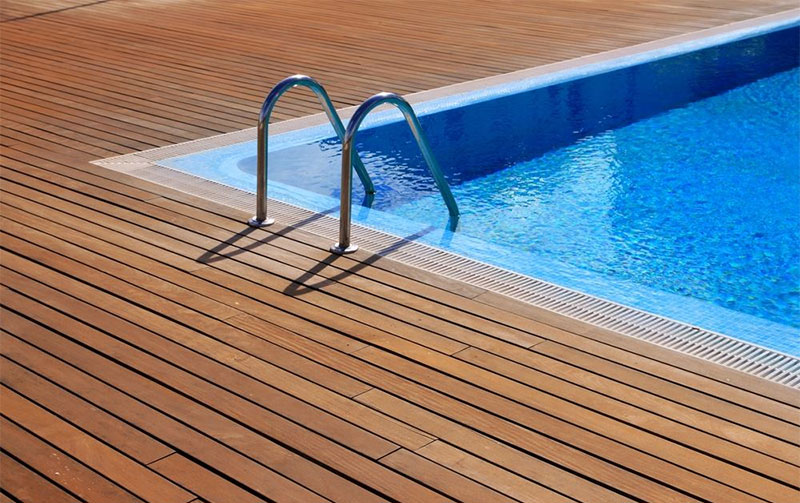
Interested in High-Quality Composite Decking for Your Pool?
If you are ready to enhance your swimming pool area with premium composite decking, consider reaching out to trusted manufacturers who specialize in durable and eco-friendly WPC decking solutions.
Hosung WPC offers a wide range of composite decking products designed specifically for wet, high-traffic environments like swimming pools. Their boards feature superior slip resistance, weatherproofing, and aesthetic options to fit any pool design.
Contact Hosung WPC to explore their product line, request samples, and get professional guidance tailored to your project needs.
Composite decking for swimming pools is a smart investment that elevates your outdoor living experience while providing safety, beauty, and lasting value. Use this guide to choose the perfect decking material and supplier, ensuring your poolside area becomes the ultimate place for relaxation and enjoyment.

